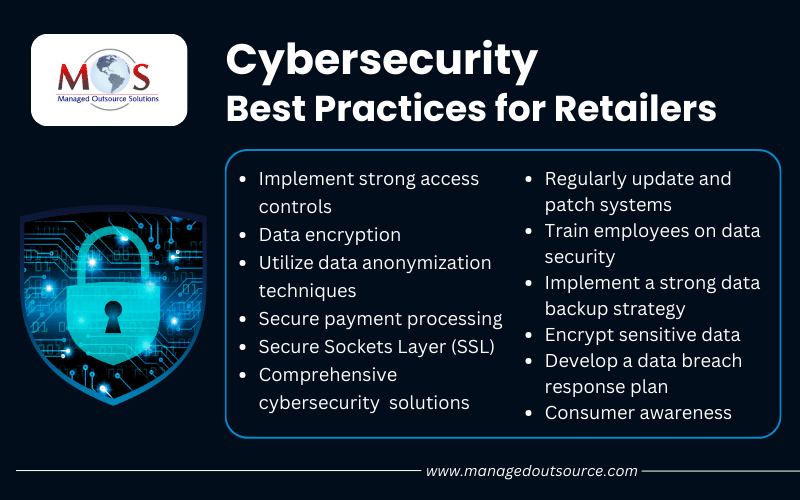Modern businesses rely on digital technology for communication, commerce, and critical infrastructure. With the use of computerized systems for their daily operations, ensuring cyber security is necessary to protect data from breaches, ransomware attacks, and hacks. Retail businesses need to be especially vigilant about data security as they handle sensitive customer information, payment details, and internal data that are attractive targets for cybercriminals. For instance, data security is a major concern for retail businesses that outsource data entry. In such situations, choosing a reliable provider of business process outsourcing services is essential to ensure data confidentiality and minimize cyber security risks.
Report indicates Massive Retail Data Breaches
The 2023 Data Breach Investigations Report identified system intrusion, web application attacks, and social engineering as the most significant threats to retail businesses. Asimily reported on a significant cyberattack that compromised major fashion retailer JD Sports in 2023. Hackers breached a server containing customer order information, stealing data from approximately 10 million individuals. This data included names, addresses, email addresses, phone numbers, order details, and the last four digits of payment cards. The breach affected not only JD Sports but also its group brands, including Size?, Millets, Blacks, Scotts, and MilletSport. This stolen data could be used for social engineering attacks or sold on the dark web for further criminal activities.
Here are some practical steps retail businesses can take to protect customer data.
12 Cyber Security Measures for Retail Businesses
- Implement strong access controls
Businesses should limit access to sensitive data based on employee roles. Only those who need access to specific information should have it. Implementing Multi-Factor Authentication (MFA) can help. MFA requires multiple forms of verification before gaining access to critical systems, such as a password and a fingerprint or a one-time code sent to a mobile device. Conduct regular audits of access logs to identify and respond to any unauthorized access attempts.
- Data encryption
Data encryption uses an encryption key and an algorithm to create a ciphertext. This cipher text is stored in the database and remains safe from outside attackers. It is important that every in-store transaction is encrypted within the payment terminal before it is transported over a secured connection. Auditing of in-store payment terminals regularly is required to ensure that modified credit card readers have not been installed over the genuine terminal.
- Utilize data anonymization techniques
Anonymize or de-identify sensitive customer data whenever possible, reducing the risk associated with data breaches. Use data masking techniques in non-production environments such as software development and testing. This involves hiding data with altered values, such as replacing a value character with a symbol like “*” or “x”. This will ensure that developers and testers work with anonymized data rather than real customer information.
- Secure payment processing
Adhering to the Payment Card Industry Data Security Standard (PCI DSS) can protect credit card information. This includes using secure payment gateways, encrypting payment data, and regularly testing security systems. Tokenization can also be used to protect sensitive data. Payment tokenization replaces sensitive payment information, such as credit card numbers, with a unique, random set of characters called a “token”. Unique tokens keep payment data safe from hackers during transactions because the actual card information is not being used or stored, reducing the risk of data breaches.
- Secure Sockets Layer (SSL)
SSL is a crucial security protocol that safeguards online communication by thwarting various cyberattacks. SSL authenticates web servers, ensuring that users are connecting to the legitimate website. This is vital because attackers often create fake websites designed to mimic genuine ones, aiming to deceive users and steal sensitive information. SSL also encrypts data transmitted between the user’s browser and the web server, preventing attackers from intercepting and tampering with it.
- Comprehensive cybersecurity solutions
Implementing advanced firewalls and IDS can monitor and protect against unauthorized access and cyberattacks. Additionally, it’s critical to regularly update and use anti-malware and anti-virus software to protect systems from malicious software and threats. Using Security Information and Event Management (SIEM) tools can ensure continuous monitoring to detect and respond to security threats across the entire network.
- Regularly update and patch systems
All systems, including operating systems, software, and applications should be up to date with the latest security patches to protect against known vulnerabilities. Using automated patch management can ensure that updates and patches are applied consistently and promptly across all systems.
- Train employees on data security
Employees should be regularly updated on data security best practices. Security awareness training can help them recognize phishing attempts, the importance of using strong passwords, and the need to follow proper data handling procedures. Conducting simulated phishing attacks is a practical way to test and reinforce employees’ ability to detect and avoid phishing scams.
- Implement a strong data backup strategy
Performing regular backups of all critical data ensures that information can be restored in case of a cyberattack or system failure. Backups should be stored in secure offsite locations or in the cloud, with encryption, to protect against data loss from physical damage or localized attacks.
- Encrypt sensitive data
Strong encryption protocols (like AES-256) should be to encrypt data stored on servers, databases, and backups, as well as data transmitted over networks. Implementing end-to-end encryption will ensure that all data, from the point of entry (e.g., during a transaction) to storage, is encrypted to prevent interception.
- Develop a data breach response plan
You need a plan in place for when a data breach happens, and that’s where a data breach response plan comes in. Set up a dedicated team responsible for responding to data breaches, with clear roles and responsibilities. Figure out the scope of the breach, like what data was compromised and how it happened. Immediately take steps to prevent further damage, including notifying affected customers and regulatory bodies. Conduct a thorough review after the incident to identify weaknesses and improve security measures to prevent future breaches.
- Consumer awareness
While it is the retailers’ responsibility to ensure that their customer data and payment information are safe, customers should ideally be kept informed about the business’s implemented security standards and protections. One best practice is advising them on matters what they can do to keep their personal information safe, such as not reusing passwords. IBM Security’s Future of Identity Study showed that 41 percent of millennials use the same password to access many accounts. A compromised password could give cyber criminals access to multiple accounts. Louise Byrne, an IBM Security Marketer, was unable to log in to a music streaming service for which she paid a monthly fee. She subsequently found that the breach occurred because she had used her email address and password combination unwisely for various sites, which could have been leaked. Her email ID and password was exposed in at least four breaches. So, consumers should be advised not to reuse passwords across diverse websites.
Last but not least, monitor your third-party vendors. Many retail businesses outsource data entry, data processing, and other related tasks to business process outsourcing companies. If you do so, make sure to evaluate and monitor the security practices of the BPO company as it has access to your data or systems. Make sure that they adhere to strict security standards and have proper data protection measures in place. Including security requirements in contracts and service level agreements (SLAs) with vendors will ensure they are held accountable for protecting your data.
Learn about our secure and reliable business process outsourcing solutions!





